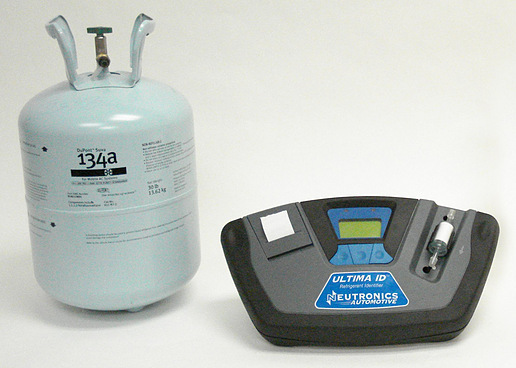HFO-1234yf encounters resistance as R-134a replacement for A/C

R-134a will continue in production, but identifying it vs. HFO-1234yf will require premium refrigerant identifiers.
HFO-1234yf, virtually crowned as the global-warming A/C refrigerant replacement for R-134a, suddenly faces opposition. Unless there are significant policy changes, it could be limited to OE installations, and perhaps fewer than anticipated. The issues were raised during a meeting of the SAE Interior Climate Control Committee at the SAE 2010 World Congress in Detroit.
Long-standing objections have been focused on anticipated initial cost, which the U.S. EPA estimates to be $45-50 lb for OE supplies. The refrigerant costs more to make and reportedly requires new plants, rather than conversion of a existing facilities. However, the actual cost of producing HFO-1234yf is unknown, and the chemical companies, clearly unsure of the market, are reportedly looking to cover more costs in the short term. So the industry faces the problem of gaining acceptance for the refrigerant until production efficiencies and competition lower the cost closer to that of R-134a.
The EU requires a low-global-warming alternative to R-134a effective on "new type" vehicles starting January 1, 2011, just eight months away. However, no chemical company has built a new plant yet companies seemingly believe the market will be small for some time, as plant construction reportedly takes about two years. The limited supply requirements apparently will be met from small "pilot plants," further exacerbating the cost issue.
One chemical company representative cited the initial high cost of R-134a, which was as much as $15-20 lb. and now is as low as $3 lb. However, he conceded, R-12 was on a firm phase-out schedule and its price soared, whereas R-134a will continue in production. Several ICCC meeting attendees wondered whether the chemical companies will gamble on full-scale production of R-1234yf to be able to lower the price. Or will they hold initial price relatively high, risking slow acceptance and perhaps being supplanted by alternatives before it can get a toehold?
A further complication is that at least one leading refrigerant supplier, Arkema, is unwilling to commit to HFO-1234yf until all patent issues are resolved, and at least three patents covering the refrigerant are known. SAE International policy is that standards avoid use of patented products unless patent holders have issued releases or negotiated a FRAND (Fair, Reasonable, and Non-Discriminatory) access agreement with all qualified parties. Arkema said to date that it has not yet succeeded in resolving the patent issues, and the two patents will be in effect for many years.
Carmakers will install HFO-1234yf in systems upgraded to deal with the refrigerant's mild flammability. However, studies discussed at the ICCC meeting indicate the same systems also could be run with R-134a at similar performance levels. Further, work is being done to use the same poly alkylene glycol (PAG) oil with both refrigerants. That would raise the question of HFO-1234yf use in the service industry, certainly in the U.S.
At the OE level, HFO-1234yf is planned for use initially in small-capacity systems, such as in the Chevrolet Cruze with its 1.0-lb (0.5-kg) system, to begin the changeover at lowest possible cost. Carmakers get fuel-economy and global-warming credits for using the new refrigerant in the U.S. In Europe, the EU law is the issue, but careful working of production schedules could limit the liability to equip "new type" vehicles to low volume, to deal with any cost/supply problem.
But either in Europe or the U.S., the possibility of independent service shops using R-134a to service systems with HFO-1234yf is high. The do-it-yourself market is huge in the U.S. and England and not significantly smaller in continental Europe. Car dealers in the U.S. and Europe will be required to buy specific equipment for the new refrigerant and they will likely service cars with it during the warranty period. But subsequently, they will face competition from independent shops that will, unless U.S. law changes, be able to legally service HFO-1234yf systems with any refrigerant on the EPA's SNAP (significant new alternatives policy) list, which includes R-134a and other refrigerants (including blends) approved originally for R-12 retrofit.
There will be special fittings for HFO-1234yf systems, just as there are special fittings for R-134a. But adapters quickly find their way into the service shops.
Initially, dealers likely would use HFO-1234yf for service during warranty. But as an ICCC meeting attendee pointed out, a car could have been given other, nonwarranty service by an independent shop (that required removal of the refrigerant as part of service access). If that independent didn't have a machine for HFO-1234yf, it might have simply serviced the system with R-134a.
So if nothing else, checking a system before service with a refrigerant identifier will be an important part of any A/C job. The resulting after-warranty service market could become a jumble, with dealers still servicing with HFO-1234yf, independent shops using R-134a for all, and dealers who decide to fight the independent competition by also servicing HFO-1234yf systems with R-134a.
The once clear-cut future to HFO-1234yf now is so murky that ICCC Chairman Ward Atkinson of Sun Test Engineering again raised the possibility of the secondary-loop system. In that, the refrigerant circuit is confined to under-hood, so a low-global-warming flammable refrigerant such as propane or the mildly flammable R-152a can be used in a protected environment. There it runs through a heat exchanger, chilling a liquid coolant, which then circulates through a passenger compartment (under-dash) heat exchanger.
HFO-1234yf is the preferred choice, even in Germany, where work on carbon dioxide (called R744 as a refrigerant) was mothballed to join what appeared to be a worldwide consensus.
One quietly voiced hope: that we're in a "lover's spat" period, that agreements will come, including some R-134a taxation to reduce the price gap.